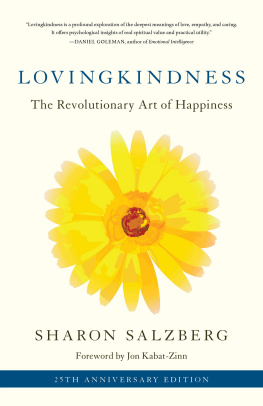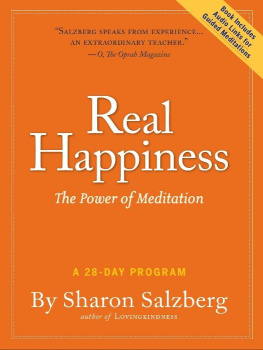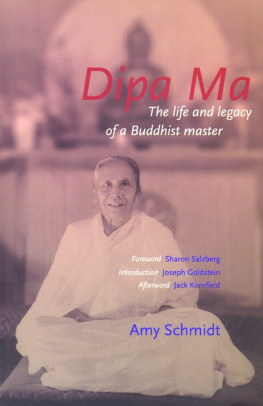Sharon Salzberg understands the power of story, skillfully [employing] anecdotes from her own life and others to enliven Buddhist teachings and to demonstrate their relevance to every aspect of life. Salzberg has written a book brimming with the mindfulness, wisdom, and compassion that she teaches so well.
Publishers Weekly
ABOUT THE BOOK
The Buddhist teachings have the power to transform our lives for the better, says Sharon Salzberg, and all we need to bring about this transformation can be found in the ordinary events of our everyday experiences. Salzberg distills more than twenty-five years of teaching and practicing meditation into a series of short essays, rich with anecdotes and personal revelations, that offer genuine aid and comfort for anyone on the spiritual path. Many chance moments, both small and profound, serve as the basis for Salzbergs teachings: hearing a market stall hawker calling I have what you need!; noting hotel guests reactions to a midnight fire alarm; watching her teacher, Dipa Ma, bless a belligerent dog; seeing the Dalai Lama laughing uproariously at his own mistake. Each passing moment, Salzberg shows, can help us down the path toward a seamlessness of connection and an unbounded heart.
SHARON SALZBERG is one of Americas leading spiritual teachers and authors. A practitioner of Buddhist meditation for over thirty years, she is a co-founder of the Barre Center for Buddhist Studies and the Insight Meditation Society, and she directs meditation retreats throughout the United States and abroad.
Sign up to learn more about our books and receive special offers from Shambhala Publications.

Or visit us online to sign up at shambhala.com/eshambhala.
A HEART AS WIDE AS THE WORLD
Stories on the Path of Lovingkindness
Sharon Salzberg

SHAMBHALA
Boston & London
2012
Shambhala Publications, Inc.
Horticultural Hall
300 Massachusetts Avenue
Boston, Massachusetts 02115
www.shambhala.com
1997 by Sharon Salzberg
Cover photograph by Andrew Olendzki
Permission has been granted to reprint material from the following sources: From Rilkes Book of Hours, translated by Anita Barrows and Joanna Macy, 1996 by Anita Barrows and Joanna Macy, reprinted by permission of Riverhead Books; from Tao Te Ching, by Stephen Mitchell, 1988 by Stephen Mitchell, reprinted by permission of HarperCollins; from Dialogues with a Modern Mystic, by Andrew Harvey and Mark Matousek, 1994 by Andrew Harvey and Mark Matousek, reprinted by permission of Quest Books; from The Spring of My Life, by Kobayashi Issa, translated by Sam Hamill, 1997 by Sam Hamill, reprinted by permission of Shambhala Publications. An earlier version of Faithto Place the Heart Upon appeared in Tricycle: The Buddhist Review, vol. VI, no. 2.
All rights reserved. No part of this book may be reproduced in any form or by any means, electronic or mechanical, including photocopying, recording, or by any information storage and retrieval system, without permission in writing from the publisher.
The Library of Congress catalogues the hardcover edition of this book as follows:
Salzberg, Sharon.
A heart as wide as the world: stories on the path of lovingkindness / Sharon Salzberg.1st ed.
p. cm.
eISBN 978-0-8348-2428-7
ISBN 978-1-57062-340-0 (cloth: alk. paper)
ISBN 978-1-57062-428-5 (pbk.)
1. Religious lifeBuddhism. I. Title.
BQ5395.S25 1997 97-16985
294.3444dc21 CIP
IT IS COMPASSION that removes the heavy bar, opens the door to freedom, makes the narrow heart as wide as the world. Compassion takes away from the heart the inert weight, the paralyzing heaviness; it gives wings to those who cling to the lowlands of self.
NYANAPONIKA THERA
Contents
I AM FOREVER GRATEFUL to His Holiness the Dalai Lama of Tibet, Aung San Suu Kyi of Burma, and all of my teachers, many of whose stories appear on these pages.
I would like to thank Sam Bercholz, who suggested I write another book, and Peter Turner, who made it real in the beginning, in the middle, and at the end.
The direction of this book was inspired by several important conversations, most notably with Alice Walker. Ongoing dialogues about spirituality and social action with Tara Bennett-Goleman, Mirabai Bush, Gary Cohen, Ram Dass, Carol Densmore, Amy Elizabeth Fox, Joseph Goldstein, Dan Goleman, Paul Gorman, Enid Gorman, Colin Greer, Joan Halifax, Charlie Halpern, Susan Halpern, Kedar Harris, and Jai Lakshman have changed my understanding in many ways.
Shoshana Alexanders visionary and editorial direction on the book were essential; plus, to whatever degree I am learning how to write, it is because she is teaching me. I also want to thank Kate Wheeler for revealing to me the point of some of my stories; and David Berman for so very many things, among them: telling me the middle path was like a fractal, turning out to be a computer genius, and staying up most of the night to make the disk. Also Hal Ross for the same late night, for turning out to be a wonderful editor, and for having a beautiful sense of service throughout.
Many people have helped me in significant ways during this period of writing, including: Seymour Boorstein, Amy Schmidt, Martha Ley, Sarah Doering, Sunanda Markus, Chris Desser, Anne Millikin, and John Friend. Eric McCord offered great service in clarifying text and creating a sequence to my flow of ideas. More people than can possibly be named helped in searching for a title for the book, but especially Steve Armstrong and Myoshin Kelley. There are friends named in my stories, including Joseph Goldstein, Kamala Masters, and Sylvia Boorstein, who gave me permission to write about them. Stories also appear about other, unnamed friends, the legion of which includes, but is not limited to: Susan Harris, Maggie Spiegel, Gina Thompson, David Berman, Ram Dass, Kate Wheeler, Catherine Ingram, Daeja Napier, Ashley Napier, Wayne Muller, Larry Rosenberg, Ann Buck, Mitch Kapor, and Meg Quigley. It is wonderful to be able to share this lifetime with all of them.
FROM MY EARLIEST DAYS of Buddhist practice, I felt powerfully drawn to the possibility of finding a way of life that was peaceful and authentic. My own life at that time was characterized largely by fear and confusion. I felt separate from other people and from the world around me, and even oddly disconnected from my own experience. The world I experienced was sharply dualistic: self and other, us and them. This view increased my fear, which of course also increased my suffering.
Stepping onto the Buddhist path, I saw that it was possible to be free of feelings of separation and defensivenessthat one could live with a seamlessness of connection and an unbounded heart. The life of the Buddha embodied this. Wisdom and compassion consistently guided his actions, whether he was alone or with others, whether wandering through India or being still, whether teaching or silently meditating, whether with those who admired him or those who slandered him. There seemed to be no circumstance that limited his compassion; he truly had a heart as wide as the world.
The essence of the Buddhas teaching is that we all have this same capacity for compassion and for peace. This potential is not abstract or distant, not something available only to those who lived long ago in another land. A life of connection and authenticity can come completely alive for us, now. We can make it our own. Discovering that our hearts are indeed wide enough to embrace the whole world of experienceboth pleasurable and painfulis the basis of the spiritual path, and with it comes an extraordinary freedom and happiness. This way of living is beautifully described by the poet Rilke:
Next page










